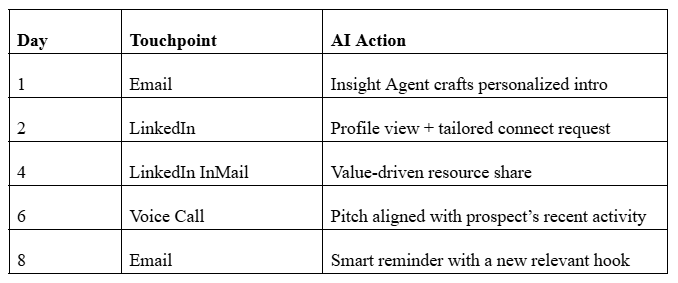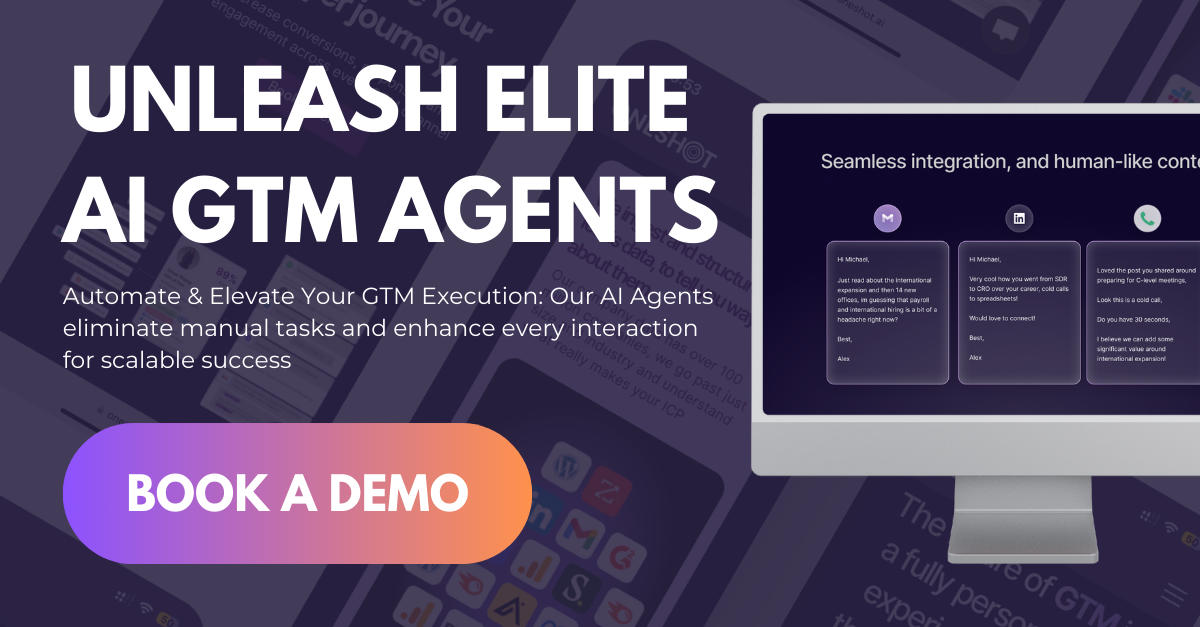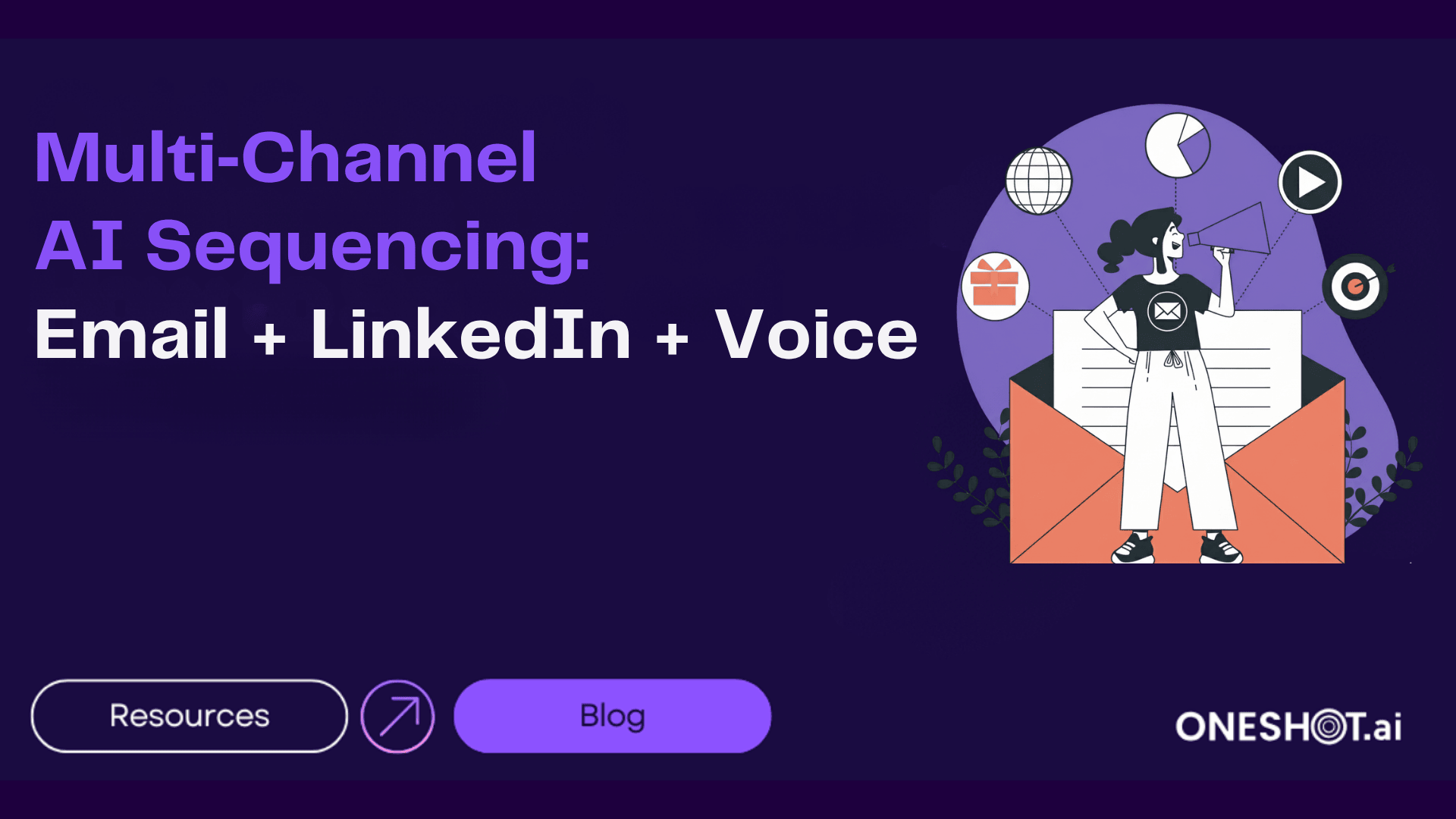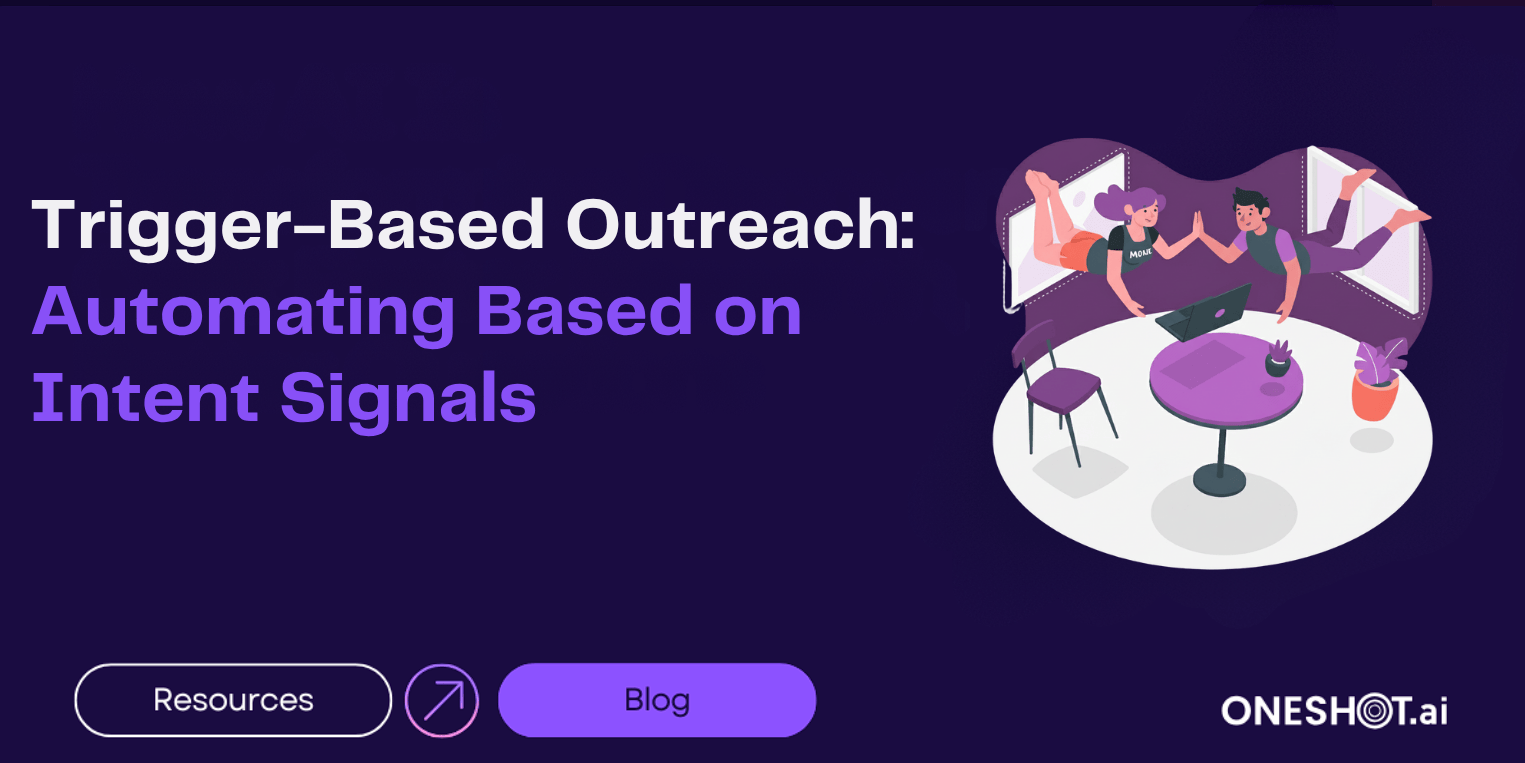Today’s B2B buyers no longer accept generic cold outreach. They demand personalized, context-specific interaction via multiple channels – email, LinkedIn, and even voice calls – before engaging in a conversation.
The catch? Manual sequencing is only possible at small scales. Reps end up toggling between dozens of tools, manually updating CRMs, and blasting cookie-cutter messages that fail to convert.
The solution is multi-channel AI sequencing--where artificial intelligence drives personal touches across email, LinkedIn, and voice in the data-driven cadence.
In this guide, we will break down the reasons why AI-powered sequencing beats singular channel outreach, how to build winning cadences, and how OneShot.ai automates the whole process so your whole team can focus on selling.
Start your free trial of OneShot.ai and see intelligent multi-channel sequencing in action.
What Is Multi-Channel AI Sequencing?
Multi-channel AI sequencing is the purposeful and parallel delivery of coordinated, personalized messages through multiple channels, which can then use AI to optimize timing, tone, and content.
AI sequencing provides a suite of tools where a rep doesn’t send standard outreach like a static email or manual sequence of LinkedIn messages — the sequences and multiple touchpoints are integrated into an automatic and smart workflow.
To provide some context for the AI sequencing capability, here are the typical touchpoints in the B2B journey:
- Email – initial personalized outreach
- LinkedIn – viewing the prospect’s profile, sending a connection, delivering value-driven InMail
- Voice – timely follow-up call, powered by enriched lead intelligence
See how OneShot.ai sequences outreach using its Insight, Persona, and Scaling Agents.
Why Multi-Channel Is More Effective Than Single-Channel
The statistics are obvious—multi-channel engagement far exceeds single-channel. Multi-channel campaigns, as per HubSpot, inspire 3.5× more engagement than single-channel outreach. SalesLoft also points out that there are usually 6–8 touchpoints before the majority of buyers will respond, not 1–2.
This tactic is effective because it enhances recall through repetition by putting your company in many contexts, establishes credibility through repeated and targeted touches, and uses AI to personalize sequencing based on engagement signals.
The contrast is dramatic: email-only campaigns enjoy a typical reply rate of a little over 8%, whereas AI-based multi-channel approaches can command reply rates of close to 28%.
The 3 Pillars of AI-Powered Multi-Channel Outreach
A. Email
AI makes email 1:1 relevant at scale (not a generic mass blast). AI creates persona-based subject lines and introductions using role-based intelligence, pulls context from the web, LinkedIn, and your CRM fields, and can initiate sends at the best times based on historical open and reply rates. Leverage the Personalization Agent in OneShot.ai to create email cadences that convert.
B. LinkedIn
AI turns LinkedIn prospecting into efficient, compliant prospecting by automating profile views, connection requests, and dynamic InMail. It interacts with prospect posts to establish familiarity prior to direct outreach, initiating warmer conversations right out of the gate.
All the while, it keeps tabs on LinkedIn's daily interaction limits to keep your accounts safe and compliant.
C. Voice (Cold Calling 2.0 with AI)
Voice still works—especially if not immediately after digital touches. AI creates customized call scripts based on any recent prospect activity, updated in real time, while the Insight Agent provides relevant talking points during the call to maintain the overall engagement.
And, every outcome from this call is automatically piped back into your sequence, so your next steps are updated based on the most recent engagement. With OneShot.ai, the latter can truly back your action with data-driven intel.
Sequence Strategy: The Rhythmic Pulse
An example AI-powered multi-channel sequence for a SaaS sales team looks as follows:

Pro Tip: AI adjusts length and channel mix of cadence by persona (for example, CTOs get fewer calls but more data-driven content).
Download your AI Sequences Template, or jump into a live session with us here. Download your free AI Sequences Template, or schedule a live walkthrough.
The Tech Behind the Strategy: How OneShot.ai Does It!
OneShot.ai's five AI agents orchestrate the multi-channel sequencing:
- Insight Agent- Enriches profiles with web, social, and intent data.
- Personalization Agent- Writes role-based mail and InMail copy.
- Integration Agent- Aligns sequences with such CRMs as Hubspot, Outreach, Apollo, and Salesloft.
- Scaling Agent- Runs sequences at scale across thousands of leads while retaining some level of personalization.
Explore OneShot.ai Integrations.

Case Study: Real Results from AI Sequencing
After implementing OneShot.ai, a B2B SaaS provider focused on enterprise, its leaders saw a transformational impact in just 90 days. Their reply rates improved by 42% over previous campaigns, prospecting time reduced by 58%, and their pipeline increased 3x in one quarter.
"OneShot.ai enabled us to scale personalization without burning our SDRs. Our multi-channel sequences now feel like 1:1 outreach," said the company's VP of Sales. Want such an impact? Have a OneShot.ai demo booked today!
Challenges & Myths of Multi-Channel AI Outreach
- Myth #1: "AI outreach is spammy."
Reality: Given good data and intelligent agents, AI is capable of delivering messaging that is more targeted than that of most human-driven campaigns.
- Myth #2: "Automation kills personalization."
Reality: AI makes hyper-personalization possible at scale—something humans can't keep up with.
- Myth #3: "LinkedIn will prohibit automated sequences."
Reality: OneShot.ai operates under platform constraints and replicates human interaction rates.
Another myth is that AI outreach is a "set it and forget it" tactic. Actually, like any multi-channel AI tactic, the most effective AI strategies require consistent, ongoing analysis, testing, and refinement.
AI gives you speed and scale, and sales leaders still need to establish a messaging strategy, monitor engagement data, and revise sequences to ensure messaging aligns with updated buyer behaviors and market practices.
Future Trends in Multi-Channel AI Sales Sequencing
New AI capabilities are coming down the pipeline that will further drive personalization. In the not-too-distant future, Voice AI will be capable of monitoring emotional tone during a call and dynamically adjusting pitch in real time for enhanced rapport.
Dynamic sequencing will dynamically rotate out-of-touch channels based on engagement patterns or sentiment signals so every touch feels fresh and on-point. Meanwhile, intent-
Real-time predictive lead scoring will allow sales organizations to prioritize the leads with the best chances of conversion.
(Source: Gartner AI Sales Trends)
These advances will cause sales teams not only to respond to prospect activity—they'll get ahead of it. Through the intersection of emotional intelligence, adaptive outreach, and predictive analytics, AI will make truly dynamic, context-sensitive engagement at scale possible.
The outcome? Reduced sales cycles, increased conversion rates, and relationships that are perceived as personal on the very first touch.

Conclusion & Next Steps
Multi-channel AI sequencing gives sales teams the worst of both worlds—humanity with efficiency in automation. With orchestration of personal touches across email, LinkedIn, and voice, they cut through noisy inboxes, engage with prospects in the channels they use, and maintain continuous momentum in their pipelines.
Every interaction is supported by real-time intelligence, so outreach is timely, pertinent, and sincere rather than forced or templated. What you end up with is a scalable strategy that doesn’t just drive activity—it drives more quality and impact in every single touchpoint.
In the rapidly changing world of sales, it is ineffective to use one outreach channel. Using one channel to reach potential customers is like fishing with one line in an ocean. You will most likely catch something, but you are leaving too much up to luck.
Multi-channel AI sequences cast a wide net while smartly adapting in real-time as buyers show interest and disposition. Whether it be InMail timed to the moment after a webinar ended, or a call following funding. AI will ensure your team reaches out to prospects at times when they would be most likely to listen.
FAQ
Q: What is multi-channel AI outreach?
It's an AI-facilitated idea of reaching prospects on different platforms in a coordinated, customized sequence-Email, LinkedIn, Voice.
Q: Can I use AI to automate my LinkedIn messaging?
Theoretically, yes: AI can be asked to send connection requests, view profiles, and send InMails that reference a prospect's activity, so long as it stops short of breaking LinkedIn's compliance rules.
Q: Is cold calling still a good strategy in 2024?
It is if it is used as a warm, multi-touch sequence and not a one-off first step. AI guarantees that the timing and talking points are just right.
Q: How do I integrate OneShot.ai with Outreach/Apollo?
OneShot.ai's Integration Agent connects with Outreach, Apollo, HubSpot, and other CRMs. Within your established workflows, your AI sequencing will run with ease.
Q: What outreach cadence looks best for B2B SaaS?
That answer depends on the persona and industry, but an optimal AI cadence often includes 6–8 touchpoints over 10–14 days, using email, LinkedIn, and voice.
Q: What impact does AI have on email open and response rates?
AI tools like OneShot.ai evaluate prospect activity, compose hyper-relevant subject lines, and deploy messages at optimum time — increasing response rates dramatically.
Q: Can AI personalize at scale?
Absolutely. AI can augment CRM data, create personalized messages for thousands of prospects, and adjust content/tone according to persona - all with no manual labor.







